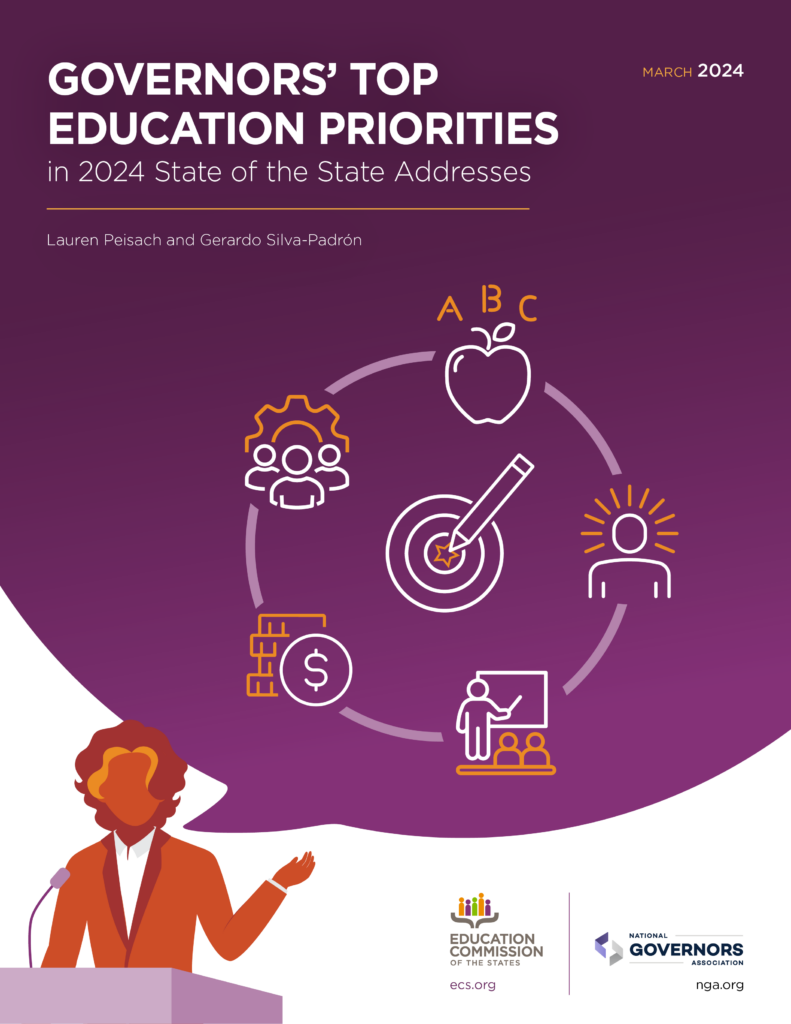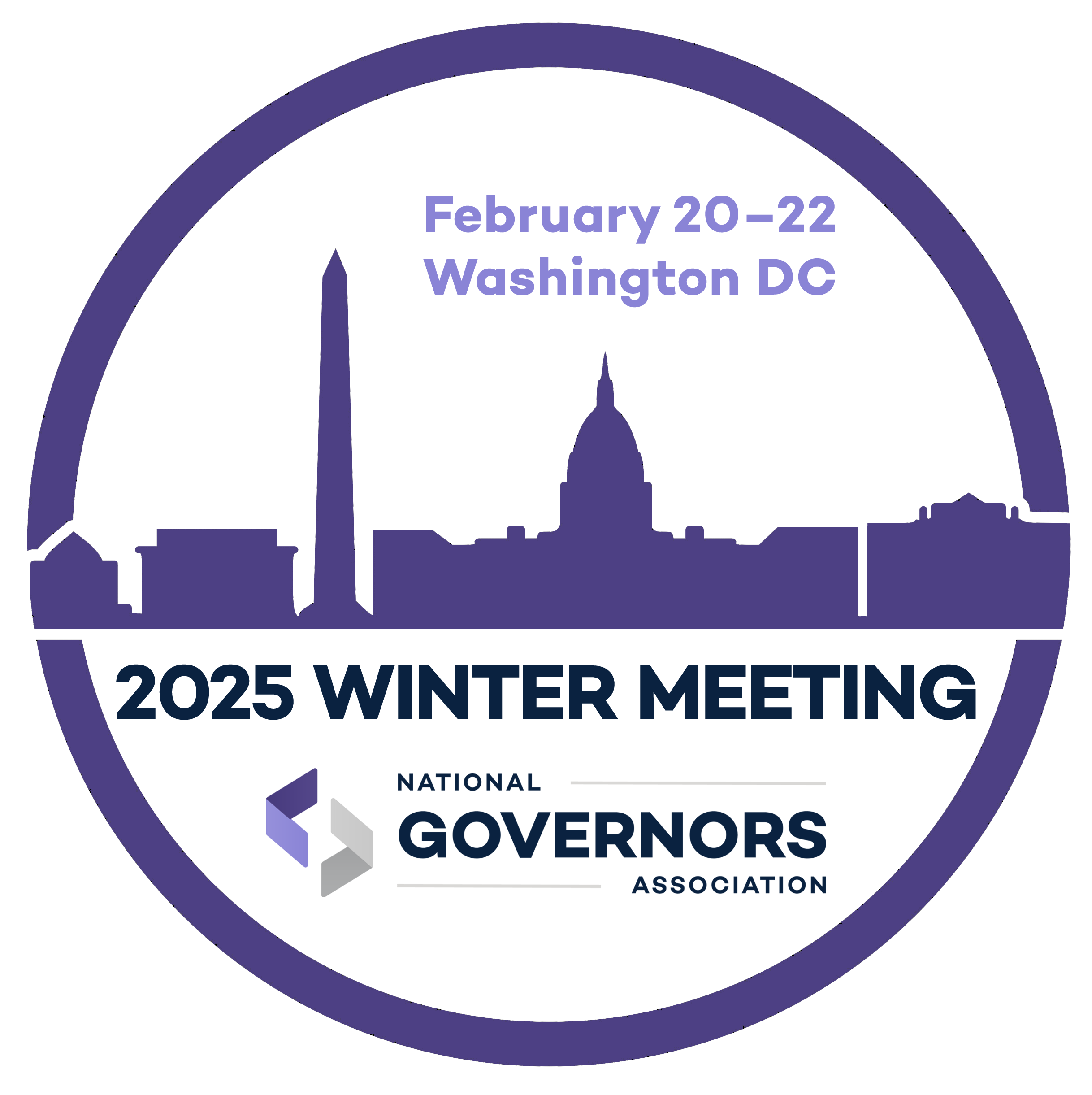The top trends across the early childhood, K-12, and postsecondary education continuum from Governors’ 2024 state addresses.

Governors across the country celebrated education achievements, introduced new education initiatives, and highlighted education as a key priority in their 2024 State of the State Addresses. By mid-March 2024, at least 44 Governors have delivered their State of the State or State of the Budget addresses.
For the past five years, NGA and the Education Commission of the States (ECS) have partnered to publish a report on key education trends across all Governors’ State of the State addresses. This year, across Governors’ addresses, six major areas in education policy have been emphasized which include workforce development and career and technical education, K-12 funding, teacher workforce, early care and education, academic achievement and literacy efforts and physical and mental health. The following features key highlights Governors have shared in their addresses across each category:
Workforce Development and Career and Technical Education
At least 38 Governors focused on workforce development and career and technical education to help expand and develop new opportunities for high school students and strengthen the current workforce. For example, in Florida, Governor DeSantis emphasized the state’s efforts on workforce education, including since 2019 that Florida students have earned more than 365,000 rapid credentials and in 2023, more than 235,000 students earned an industry certificate before high school graduation. Governor DeSantis also noted that 229,000 students are currently enrolled in career and technical education programs at Florida colleges. In Guam, Governor Leon Guerrero celebrated the territories’ efforts to increase participation in the Guam Registered Apprenticeship Program and paid summer internship opportunities for high school Juniors and Seniors. Governor Guerrero also called on the state to increase opportunities for students to engage in more in-school, skills-based training and Career Connected Learning. Louisiana Governor Jeff Landry called to remove barriers of employment in Louisiana by addressing the recognition of universal occupational licensures. In Maine, Governor Mills highlighted that her Jobs Plan had invested more than $200 million in job training, credentialing, apprenticeships, career exploration, and career and technical education. In Mississippi, Governor Reeves called on the Legislature to enact an apprenticeship education model for high school seniors so that they can meet graduation requirements while being paid to develop the skills needed for their career. In Oklahoma, Governor Stitt celebrated high schools focused on career training and called for more workforce-oriented schools to ensure career readiness. In Tennessee, Governor Lee proposed expanding apprenticeships in healthcare to address the state’s workforce shortages and ensure greater access. In, Governor Bryant highlighted their state’s increased student participation in the Jobs for America’s Graduates (JAG) program to help ensure college and career readiness. In Washington, Governor Jay Inslee celebrated the success of the Computing for All’s pre-apprenticeship program, supported by the Career Connect Washington grants. Learn more about NGA’s Workforce Development and Economic Policy and Postsecondary Education Program Areas.
K-12 Funding
At least 31 Governors discussed K-12 finance, celebrating investments in K-12 education and proposing additional allocations in areas of student transportation, special education, meals and academic and mental health services. For example, in Georgia, Governor Kemp proposed $1.4 billion in additional funds in K-12 education allocated for a total of $12.8 billion in the amended 2024 budget and fiscal year 2025 budget. In Kansas, Governor Kelly touted the state’s five straight years of fully funding Kansas schools and highlighted her budget’s proposal for putting the state on track to fully fund special education. In Maryland, Governor Moore highlighted his proposed record funding for K-12 schools and celebrated fully funding the Blueprint for Maryland’s Future. In Michigan, Governor Whitmer emphasized the record bipartisan investments in education since she took office, including raising per-pupil funding by 22 percent in five years. In Nebraska, Governor Pillen noted that the state invested $1 billion into the Education Future Fund to support K-12 education during his first year in office, including increases in special education funding. In South Dakota, Governor Noem stated that K-12 funding has increased more than 26 percent since she took office. In Vermont, Governor Scott noted that Vermont’s Education Fund is more than $2.1 billion and that the state spends $25,000 per student annually, one of the highest per-pupil funding in the country and he called on the Legislature to work with him to contain spending.
Learn more about state education budgets and other trending topics in NGA’s State Strategies for Addressing K-12 Student Needs Webinar Series.
Teacher Workforce
At least 27 Governors highlighted educator workforce needs including recruitment, retention, and compensation strategies. For example, Arizona Governor Hobbs called for an increase in compensation for teachers and support staff and highlighted their critical role in student success, building off of her Governor’s Education Retention Task Force Report last year. In Delaware, Governor Carney recognized the efforts of his Public Education Compensation Committee and called for increased compensation for educators. In Idaho, Governor Little celebrated increasing pay for teachers at all levels of experience and boosting health insurance benefits for teachers and staff. In Illinois, Governor Pritzker highlighted Illinois’ $45 million teacher pipeline grant program launched last year and proposed an additional $45 million for the program this year. In Indiana, Governor Holcomb noted the historic investment in average teacher pay across the state to reach the salary goal of $60,000 this year. In Pennsylvania, Governor Shapiro noted that there are 5,500 teacher vacancies across the state and that he took action to address this challenge last year through a number of pipeline initiatives, including providing stipends for student teachers. Utah Governor Spencer Cox highlighted the largest increase in teacher salaries in the state’s history. Learn more about NGA’s State Snapshots for Strengthening the Educator Workforce Webinar Series.
Early Care and Education
At least 25 Governors discussed child care and early learning, including preschool, Kindergarten, and the early childhood workforce. For example, in Hawaii, Governor Green touted the state’s efforts to increase access to preschool for Hawaii’s children. In Kentucky, Governor Beshear called for universal pre-K for all four-year olds. In Missouri, Governor Parson proposed three new child care tax credit programs to improve access and additional investment in Missouri’s child care subsidy program to increase affordability for families seeking child care across the state. Governor Parson also noted his continued support for the expansion of pre-K programs. In New Hampshire, Governor Sununu highlighted that the state now has full-day kindergarten, In New Jersey, Governor Murphy called for redoubling the state’s commitment to providing universal pre-K to all children across the state. In New Mexico, Governor Lujan Grisham noted that New Mexico is the only state in the United States with a constitutional right to child care and proposed two new early literacy programs. In North Dakota, Governor Doug Burgum emphasized the importance of affordable and quality child care and stated that $66 million alongside of federal funds went into the North Dakota child care initiative to help families with child care costs and child care businesses.
Learn more about the Children and Families Program Area, including their summary of gubernatorial conversations on child care at the 2024 NGA Winter Meeting last month.
Academic Achievement and Literacy
At least 24 Governors highlighted student achievement in their state and discussed efforts in literacy, numeracy, and attendance. In Alabama, Governor Ivey noted her efforts on literacy, numeracy, school turnaround and the recent release of a report from the Governor’s Commission on Teaching and Learning that included recommendations for improving education in the state over the next three years. In Alaska, Governor Mike Dunleavy focused on the implementation of the Alaska READS Act to ensure every student achieves proficiency in reading by third grade. In American Samoa, Governor Mauga highlighted his K-3 Early Literacy Skills Initiative being implemented in 23 elementary schools across the territory. In Colorado, Governor Polis emphasized his efforts to provide students and educators with more support in math and science, including through out-of-school opportunities. In Connecticut, Governor Lamont highlighted the state’s Learner Engagement and Attendance or LEAP program to help address chronic absenteeism across the state. In Iowa, Governor Reynolds announced new efforts aimed at providing support for educators to teach literacy based on the Science of Reading approach. Similarly, in New York, Governor Kathy Hochul announced the Back to Basics reading plan to ensure every school district utilizes instructional best practices grounded in the Science of Reading. In Rhode Island, Governor McKee highlighted his Learn365RI Initiative to address chronic absenteeism. In Virginia, Governor Youngkin highlighted his ALL-IN Virginia Plan to provide intensive math and reading tutoring in the foundational years of 3rd – 8th grade.
Physical and Mental Health
At least 20 Governors discussed physical and mental health including behavioral health efforts for students and school staff. In California, Governor Newsom proposed $4.7 billion for children and youth behavioral health and $4.1 billion for community schools. In Massachusetts, Governor Healey highlighted the expansion of school-based health support from early childhood through higher education and announced the launch of 26 community behavioral health centers to provide urgent and in-person crisis response. In South Carolina, Governor McMaster celebrated that the number of school-based mental health counselors in public schools doubled from January 2022 to September 2023. In Wisconsin, Governor Evers emphasized the investment in the Get Kids Ahead Initiative providing school-based mental health services statewide. West Virginia Governor Justice noted the success of West Virginia’s Communities in Schools. Additionally, in Wyoming, Governor Gordon underscored the importance of suicide prevention and addressing mental health in schools and called on the Legislature to his mental health funding package. Learn more about NGA’s Student and School Staff Well-Being Project, Youth Mental Health Policy Academy and Strengthening Youth Mental Health: A Governor’s Playbook.
The joint report also noted that two additional areas were emerging trends for Governors in their State of the States this year: at least 19 Governors mentioned school choice and at least 15 Governors mentioned postsecondary affordability.
This article was developed by Seth Gerson and Jillian Meinhardt. Please visit NGA’s K-12 Education page for ongoing updates of webinars and resources, convenings, and technical assistance support for Governors and their policy advisors.













